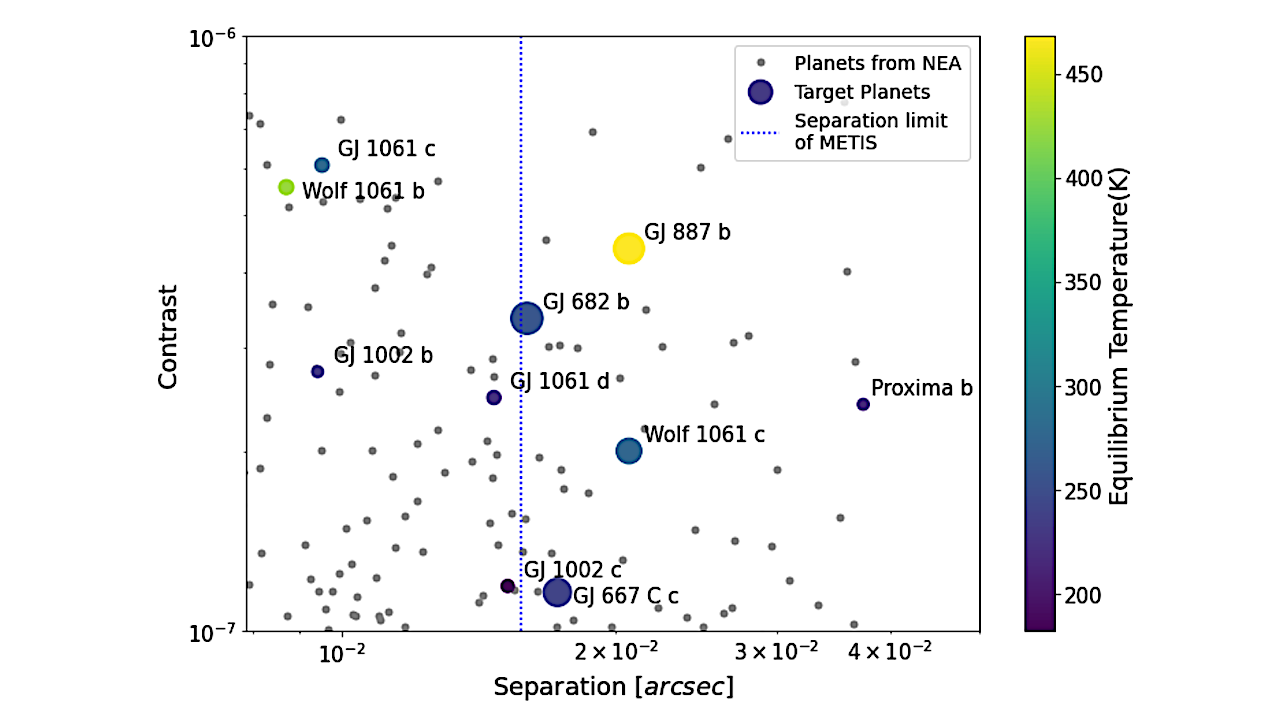
For ELT/HARMONI and ELT/METIS, we select 10 and 5 candidate planets around nearby stars. Because the spatial resolution of ELT/HARMONI is smaller than the plotting limit, we show only the spatial resolution for ELT/METIS as a vertical dotted blue line. Planets located to the right of the dotted line are suitable planets for ELT/METIS. All colored dots are suitable planets for ELT/HARMONI. The color dot size is proportional to the planetary radius. The color of the dot is based on the equilibrium temperature. All colored data points are candidate planets listed in Table 1. Selection criteria can be found in §2.1. Gray dots are planets emerging from the NEA that are less suitable for direct imaging with the ELT. – astro-ph.EP
In the coming decades, one of the primary goals of exoplanet science will be to search for habitable planets and signs of extraterrestrial life in the universe.
Signs of life can be indicated by thermodynamic imbalances in terrestrial planetary atmospheres. Signs such as O2 and CH4 in modern Earth’s atmosphere are commonly called biosignatures. These biosignatures in exoplanetary atmospheres may be detected by high-contrast imaging instruments on future Very Large Telescopes (ELTs).
To calculate the signal-to-noise (S/N) ratio with ELTs, we select 10 nearby rocky planets and simulate medium-resolution ( R ∼ 1000) direct imaging of these planets using the Mid-Infrared ELT Imager and Spectrograph (ELT). /METIS, 3-5.6 μm) and the High Angular Resolution Monolithic Optical and Near-Infrared Integrated Field Spectrogram (ELT/HARMONI, 0.5-2.45 μm).
We calculate S/N to detect biosignatures including CH4, O2, H2O and CO2. Our results show that GJ 887~b has the highest detection S/N for biosignatures and that Proxima Cen b exhibits the only detectable CO2 among targets for ELT/METIS direct imaging.
We examine the TRAPPIST-1 system and the basic class of nearby transiting rocky planetary systems, and compare the biosignature detection S/N of transit spectroscopy with JWST and direct spectroscopy with ELT/HARMONI. Our findings indicate that JWST is well suited to detect and characterize the atmospheres of transiting planetary systems such as TRAPPIST-1, which are relatively more distant and have smaller angular separations than nearby non-transiting planets.
Huihao Zhang, Ji Wang, Michael K. Plummer
Comments: 19 pages, 5 figures; Accepted for The Astronomical Journal
Subjects: Earth and Planetary Astrophysics (astro-ph.EP); Astrophysical Instruments and Methods (astro-ph.IM)
Citation: arXiv:2311.18117 [astro-ph.EP] (or arXiv:2311.18117v1 [astro-ph.EP] for this version)
Submission history
Posted by: Huihao Zhang
[v1] Wed, 29 Nov 2023 22:12:38 UTC (396 KB)
https://arxiv.org/abs/2311.18117
Astronomy

„Oddany rozwiązywacz problemów. Przyjazny hipsterom praktykant bekonu. Miłośnik kawy. Nieuleczalny introwertyk. Student.

